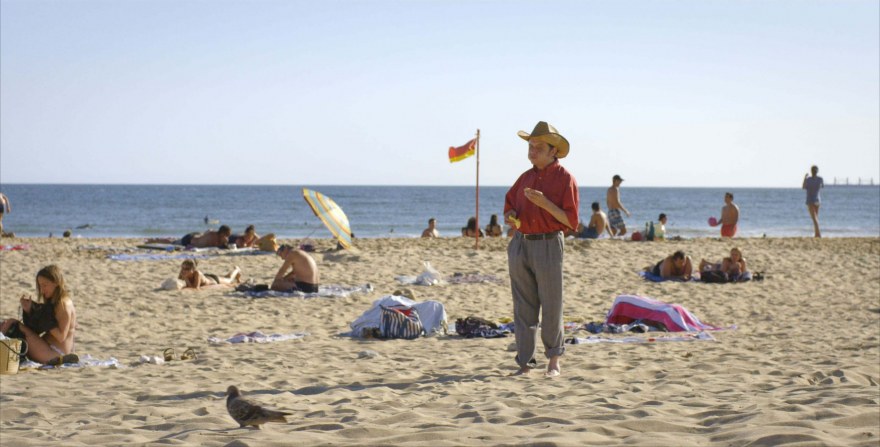Breakfast with Invisível Herói [Invisible Hero]
Interview with Christèle Alves Meira, director of Invisível Herói [Invisible Hero]
The film, I believe, is staged, but it sometimes looks documentary. How did you achieve this result?
Duarte is passionate about literature. He spends his days reading in the braille library that he built up over the years, located in the residence for blind people where he lives (filmed in the first part of the movie). He hates biographies. So it was obvious from the start that he would rather act in a fiction than in a documentary, which was my original idea. I wanted to have fun, to give the impression that everything was true while everything was (almost) false. The first part of the film thus looks like a documentary: we film Duarte in his real daily life, with his voice-over telling us about his taste for literature and inviting us to experience a journey into his imaginary world. However, the documentary style used is an illusion, as our hero soon leaves his residence to seek out his imaginary friend Léandro. For Duarte, a way to get out of your loneliness is to meet other people, enabling you to reveal yourself (or a new version of yourself). The story was very scripted; the staging, on the other hand, was precisely prepared so as to give the true impression of a documentary (most of the sequence shots, scenes filmed in the street with real life extras were shot in one take only). Working with a blind protagonist was a fantastic opportunity given to me, to question our perception of the world. Duarte invites us to see things differently, to go beyond what is apparently visible, and opens the field of the invisible.
Tell us a bit more about the background of the main character.
The character of Duarte is a mix between his true personality (a blind man passionate about literature, who lives in a seaside resort city near Lisbon, who likes singing and chatting with people) and an made-up character (a writer, linked to the Cape Verdean culture, secretly in love with a woman he photographs and for whom he wrote a song). I met the real Duarte while I was casting non-professional actors for my first feature film. I posted ads in blind people institutes and found him. We immediately became friends. Because it took more time for my feature film to get financed, we decided to make this film in the meantime.
What are your takeaways from this collaboration with Duarte?
Before I even made this film, my relationship with Duarte was very detached from his disability. I very often forget that Duarte is blind. He has such an ability to adapt, so much humor about himself, he is a man like any other. He taught me to laugh at certain situations. For example, at the beginning of our relationship, I was careful every time we went down some stairs. ” Don’t worry, I see. I have eyes on my toes and hands,” he said to me laughing. I am now convinced of it. He sees the world differently but he sees it! I had no difficulty filming him. It was very fun. Creative tips had to be found to guide him through the natural sets. But Duarte, just like me, is a great player, we had a lot of fun! I trusted him and he trusted me, so everything became possible. While writing the screenplay, I felt the need to share his vision of the handicap, freed from our preconceived ideas. We weren’t afraid of anything (not even of being ridiculous). Duarte is a free and witty man. It was very moving to show him the film when finished, as well as to his friends from the institute. The sounds, his own memories from the shooting and something else mysterious that only belong to him are elements that must allow him to see without the look.
Would you say that the short film format has given you any particular freedom?
Totally! The short format enables us to experiment things without limits. Even if I’m about to shoot my first feature film, I don’t believe in the hierarchical scale between short and feature films, that the cinema industry seems to impose us. It all depends on the subject and on the grammar we need to express ourselves. It’s a different medium, that’s all.
What do you consider your cinematographic references?
My cinematographic references vary according to the projects. For Invisível Herói, my biggest reference was related to literature. It was the heteronyms of Fernando Pessoa (who appears in the film as a statue-man) which inspired Leandro’s quest and the stroll through Lisbon. I did not have a film reference when I wrote and shot, although two great filmmakers have undoubtedly left their mark on my mind. “The adventure of the real is to follow the footsteps of the unexpected,” said Robert Bresson. Indeed, with Invisível Herói, I had to provoke reality or to learn how wait for it. I am also thinking of the work of Abbas Kiarostami who never allowed himself to shoot easy naturalism, though his fictions always kept track of the passage into reality.
Invisível Herói [Invisible Hero] is part of International Competition I3.








